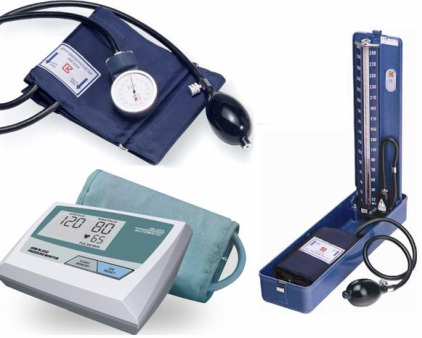
the three different types of sphygmomanometer
A person with a blood pressure reading of about 140/90 millimeters of Mercury (mmHg) is considered hypertensive. A durable medical instrument called sphygmomanometer is being used in order to gauge the person’s blood pressure level. Sphygmomanometer comes in different types. Some of them are designed with mercury manometer or aneroid gauge while others come with oscillometeric detector to obtain the systolic and diastolic value. The systolic value (the top number) identifies the pressure of blood that exerts on vessel while the heart is beating while the diastolic value (the bottom number) is the pressure in the vessels between heartbeats.
Aside from mercury or aneroid manometer (for manually operated blood pressure device) and oscillometric detector (for digital BP device), both types of sphygmomanometer are also provided with inflatable cuff (dip molded latex tube bladder covered by a durable nylon). This essential component of medical instruments for monitoring BP level is smoothly and snugly wrapped around the upper arm, perpendicular to the heart. The cuff will be inflated manually or automatically to constrict the arteries then it will be slightly deflated to release the air from the cuff so as to get the BP readings.
There are also other essential parts that can be found in sphygmomanometers with manually operated inflation cuff. These include the inflation bulb and air release valve. The inflation bulb is constructed from dip molded latex and it is used as pump so as to inflate the cuff. The air release valve, made of corrosion-proof materials, serves as control in order to keep the air in the cuff or let the air out.
Every component found in the sphygmomanometer plays an important function in order to get the most accurate BP reading. Thus, it is necessary to make sure that your blood pressure device is always in perfect condition. And this can be achieved through proper care and maintenance.
Aside from mercury or aneroid manometer (for manually operated blood pressure device) and oscillometric detector (for digital BP device), both types of sphygmomanometer are also provided with inflatable cuff (dip molded latex tube bladder covered by a durable nylon). This essential component of medical instruments for monitoring BP level is smoothly and snugly wrapped around the upper arm, perpendicular to the heart. The cuff will be inflated manually or automatically to constrict the arteries then it will be slightly deflated to release the air from the cuff so as to get the BP readings.
There are also other essential parts that can be found in sphygmomanometers with manually operated inflation cuff. These include the inflation bulb and air release valve. The inflation bulb is constructed from dip molded latex and it is used as pump so as to inflate the cuff. The air release valve, made of corrosion-proof materials, serves as control in order to keep the air in the cuff or let the air out.
Every component found in the sphygmomanometer plays an important function in order to get the most accurate BP reading. Thus, it is necessary to make sure that your blood pressure device is always in perfect condition. And this can be achieved through proper care and maintenance.
 RSS Feed
RSS Feed